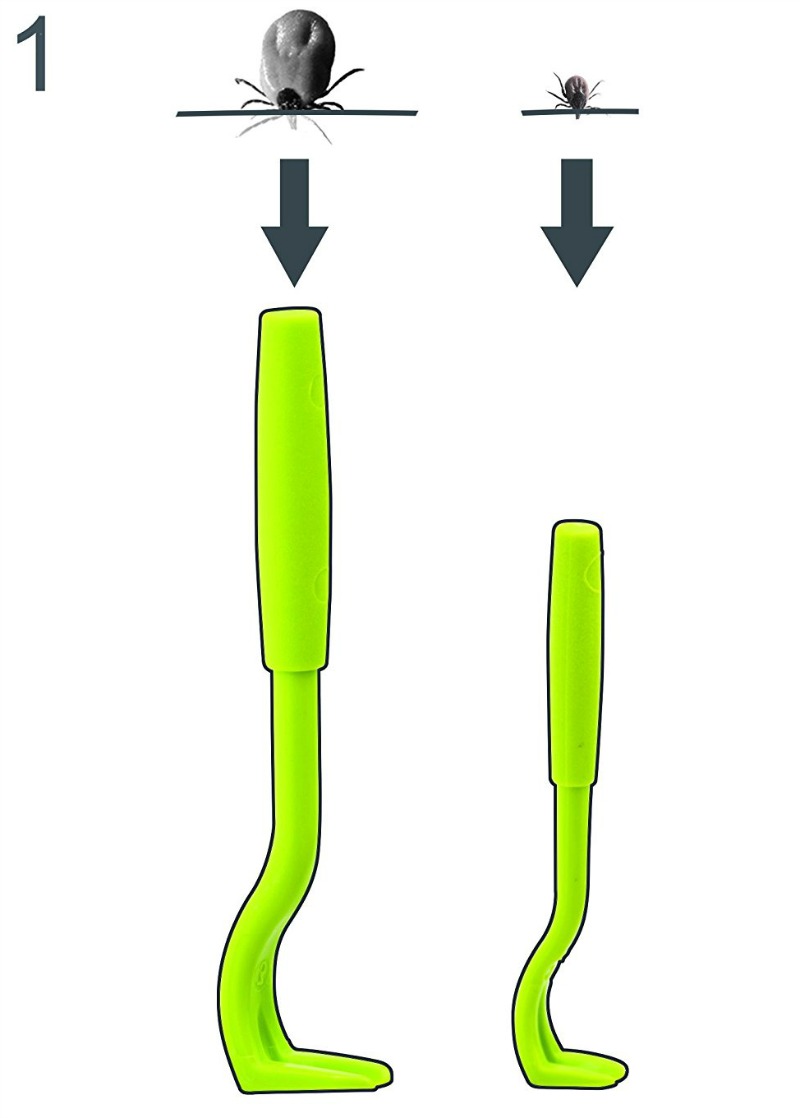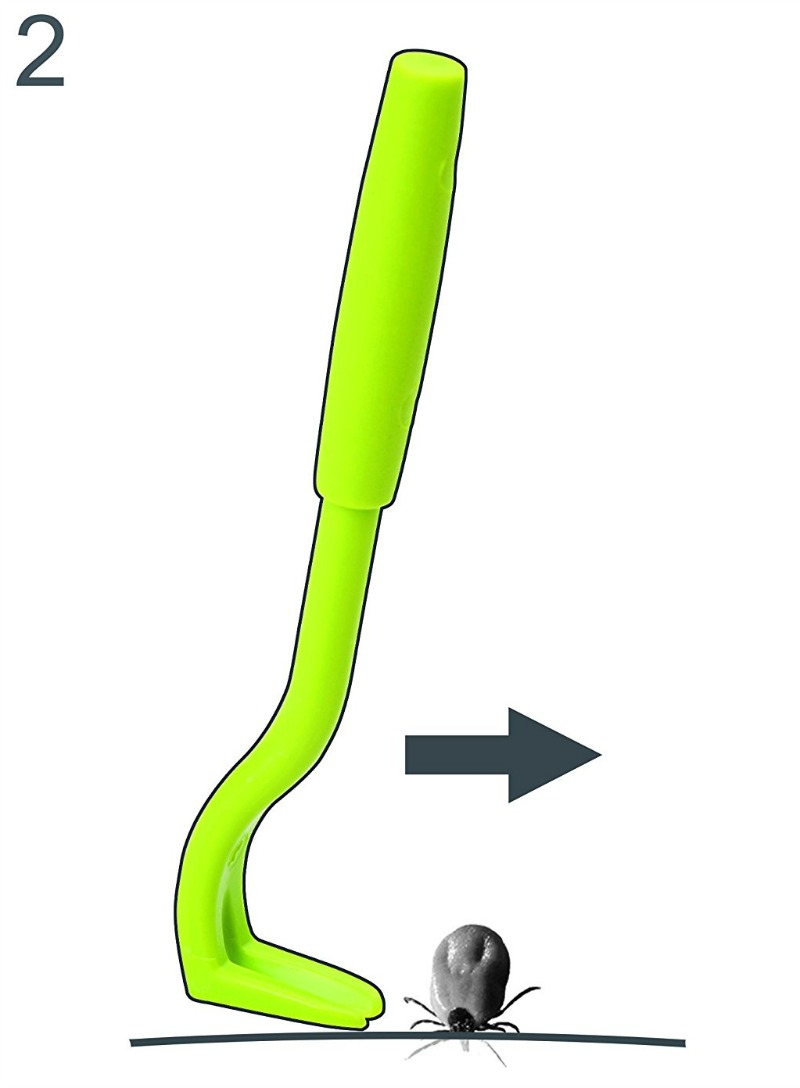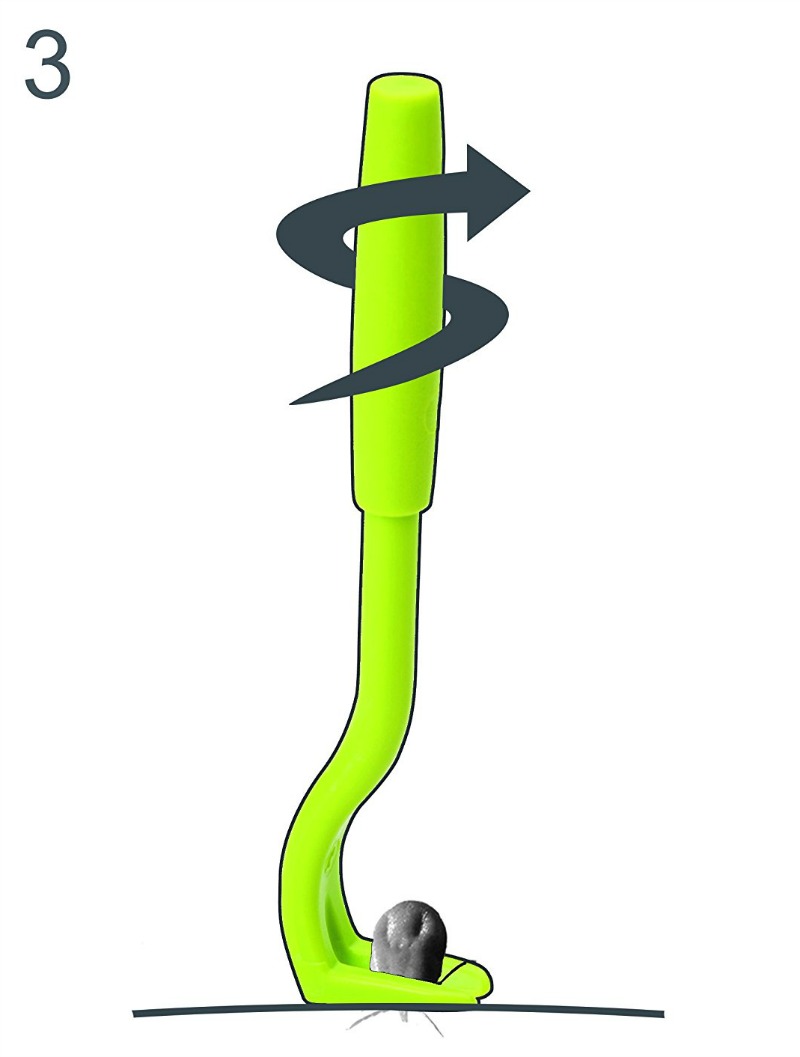Safe method to remove a tick without leaving the head stuck in the skin that works with small or large ticks and is easier than tweezers.

Each spring and summer, warmer weather and spending more time outside and camping outdoors increases the chances of exposure to nasty tick bites. The question is not “if” but “when” it will happen. And, when it inevitably does, how to remove a tick safely to minimize the chances of disease?
I have a friend who lives on a farm in Kentucky with his wife and five children. During tick season, he and his wife perform tick checks every night on all their children right before bathtime. They take ticks very seriously in their home because the Lyme disease carrying kind are very prevalent in their area.
It’s not just Lyme disease that is a potential risk either. The Journal of General Internal Medicine published an article by Susan Wolver, MD, and Diane Sun, MD, which identified a rising trend of red meat allergies from tick bites.
When one of my children was a fairly young baby and not even mobile yet, a tick lodged itself into the top of his head. Most likely, the tick dropped out of a tree onto his head, so don’t think your children are safe just because they aren’t hiking in the woods or walking in the grass!
If you discover that your child or pet has a tick that has lodged itself into the skin, here is the safest, easiest and quickest way to remove it.
How to Remove a Tick Safely and Quickly
The best way to remove ticks is using tweezers according to most authoritative sources. However, there is a new gadget called the tick twister remover that works even better.
My friend in Kentucky says that they used to use tweezers, but the tick twister is far superior and easier to use. It can be used to remove ticks from both pets and people.
Each tick twister tick removal set (it only costs about $6) has two removers inside: one large and one small. The different size is to allow for safe removal of both small and large ticks.
This ingenious device created by a veterinarian to safely remove ticks regardless of a person’s expertise has the following benefits:
- It is easier to use than tweezers especially for small ticks.
- It removes the tick without squeezing it, which greatly reduces the chances of disease transmission.
- It ensures the head and mouthparts of the tick are removed along with the body.
- It can be used for both large and small ticks.
Every home with children and/or pets should have one of these! It should also be included with camping equipment.
Safe Removal Steps. Better than Tweezers!
There are three steps for removing a tick using the tick twister.
First, you select which tick twister to use. If the tick is large, use the larger tick twister. If the tick is small, use the smaller one. Pretty simple!

Second, you grasp the tick between the head and body using the hook end of the tick twister. The picture below shows how to do it.

Third, simply twist the tick twister gently to easily and safely remove the entire tick out of the skin. That’s it!

After removing the tick, thoroughly clean the affected skin with alcohol. If there is any irritation, a dab of this herbal salve does wonders to quickly heal the skin.
Warning About some Tick Removal Recommendations
Some sources recommend pulling a tick straight out of the skin as the best method of removal.
This is very dangerous advice, because trying to pull a tick straight out will almost ALWAYS result in the head staying stuck in the skin. This is because ticks frequently lodge into the skin at an angle. They don’t usually burrow straight in perpendicular to the skin’s surface.
If you must use tweezers because you don’t have the tick twister remover available, be sure to pull the tick out at the same angle it went in.
This will give you the best shot at removing the head along with the body. In other words, grab the tick very firmly and close to the head as you can and pull out on a straight line but the same angle it burrowed in. I hope this makes sense.
It’s a little difficult to describe in words. This is the method taught to me by my Dad, who is a retired family doctor. Using this method, I’ve never left a tick’s head in the skin of any pet or person in over 40 years.
Of course, using the inexpensive tick twister is the best method of all. You don’t have to worry about angles – you simply twist the tick out of the skin!
How to Repel Ticks
This article describes the method for preparing an herbal yarrow tincture which is very effective at repelling ticks so you don’t have to remove them in the first place.
You ideally need to spray yourself every 2 hours or so.
Note that yarrow has been reputedly found by the US Army to be as effective as DEET in repelling ticks.








I have removed several by lighting a match, then blowing it out and touching the hot ember and to the ticks rear, they usually come out screaming. Or douse a cotton ball in rubbing alcohol and swab the alcohol all around it until it backs out…completely agree with the never pull with tweezers theory.
You don’t want to make a tick uncomfortable, unless you want disease germs injected into your body in the process. Read my posts and others who have posted experts’ links on how to remove a tick. Use the right tool and just pull that sucker off. Anything else will potentially give you a disease. Tweezers are recommended by tick experts, but only if they are fine points, and are used to grasp down at the head. Read my links which are from actual tick researchers. Tweezers with large points are not going to work safely.
“Trying to pull a tick straight out will almost ALWAYS result in the head staying stuck in the skin. If you must use tweezers and wish to forgo the liquid soap approach (which I feel is the safest, fastest solution) you must pull the tick out at an angle which will give you the best shot at removing the head along with the body.”
This is absolutely untrue. I have removed at least 50-100 ticks from my family or my pets and I have NEVER had the head remain under the skin. They always pull away cleanly with some skin in their little mouths. I’m not saying it can’t happen but your statement is false. Judith seems like she knows what up. I appreciate your trying to share some tips but in this case please take this post down and re-post after further research now that you have more information.
The trick is to pull very smoothly, and not too fast. It’s almost as if you start pulling, and then just hold the tension for a split second. At that point, the tick is still holding onto a little skin, but the bit of skin detaches, and the whole tick is off. Don’t jerk the tick up. That is more likely to leave the mouthparts in the skin. (It is not the head, usually.)
http://www.nytimes.com/2005/07/05/science/05real.html?_r=2&oref=slogin
“…But while burning a tick into submission is probably the most popular removal method, studies show that it can also be the worst. Getting the tick out as quickly as possible is crucial, since the likelihood of contracting Lyme disease or another infection rises steeply after 24 hours. But traumatizing the insect with heat or too much force also carries the risk of making it regurgitate, further increasing the likelihood of infection.
In 1996, a team of Spanish researchers studied 52 patients who sought treatment at a hospital after extracting a tick. They found that those who accomplished this by squeezing, crushing or burning the insects were far more likely to develop symptoms of Lyme disease or other complications than those who used the proper removal method: grasping the pest as close to the skin as possible with tweezers and then gently pulling it straight up.
Any remaining pieces should be pulled out and the site should be cleaned with a disinfectant.
Smothering Vaseline or nail polish on the tick is also a bad idea, since it can be hours before it dies from suffocation. As a precautionary step, some doctors also recommend taking antibiotics to ward off infection…”
From the above article:
“…along the way it will also encourage it to release more saliva and possibly even vomit directly into your blood stream. Considering that the main reason you want the tick gone is that it likely carries harmful diseases like Rocky Mountain Fever, having it disgorge its dinner into you is not an ideal turn of events.
If you don’t want to risk the puking part, another wives tale tells you to smother the tick with oil, sunscreen, petroleum jelly, or any other viscous liquid that is going to cover the tick and clog up it’s airways. The tick, so the story goes, will back out to get a breath. This, as nice as it sounds, is simply not true. The tick has enough air tucked away to continue feeding till it gets its fill; bad news for you, as the longer it is in you, the more chances you are taking with disease….”
I have heard from numerous sources that applying something to a tick causes them to vomit inside of you so you have a greater risk of getting a disease!!! The very best way is too just pull them off.
http://www.timelessmyths.co.uk/use-a-match-to-remove-a-tick.html
Elizabeth, about using tea tree oil, I’ve always used it and it works great!! I just put some drops on the ticks head and it dislodges itself pretty quickly!
Margriet, you really don’t want to do that. Read my earlier posts. It will make disease much more likely.
This site is excellent for all kinds of tick information. Here is their page on tick removal, with excellent directions and graphics. Note they say NOT to apply a hot match. The reason they say that also applies to anything that might irritate the tick. I highly recommend this site:
http://www.tickencounter.org/prevention/tick_removal
–Although I notice that they say you should disinfect the bite area before and after removing the tick. I would not disinfect before removal. That could irritate the tick, and I think it’s overkill. Personally, I usually don’t disinfect at all unless I have injured the tick’s body and I think some infective body fluids have gotten onto the skin. But with a fine-pointed tweezer, grasping down at the head, and pulling slowly with a firm grasp on the tick, that doesn’t happen.
I am hoping she will take this post down. I would hate for someone to be misinformed. It can be deadly.
Tick removal certainly can be a life or death issue.
I may have STARI, which is a relative of Lyme disease carried by the Lone Star tick, and is prevalent in the Southeast. There is no test for it yet (last time I looked). I believe I first got sick when I moved to this house in the ticky woods, from town. I thought I was tick-savvy, but I wasn’t. Lone Star ticks are common in my yard. I may have missed one on my back. I used to go out in the yard without repellant, but I don’t do that now.
I have been a member of an active Lyme group for years and know people who almost died from Lyme and other TBDs. I know of many dogs who did die from them, and I saved my dog from ehrlichiosis several years ago, only because I knew more than my vet. I’ve been learning about TBDs for a dozen years now, and how to avoid, test and treat them. All that information is at the “saluqi” link I posted.
And proper tick removal can make a big difference. Personally, the idea of making a tick regurgitate its infective gut contents into my skin is more disgusting than having a tick attached. I avoid handling or irritating them, get a removal tool, and just get them off ASAP.
This same post about using soap, supposedly from a nurse, has been circulating for many years, and every time it appears, posted by wonderful people who just want to be helpful, my heart sinks. (I doubt that most nurses know anything about ticks, anyway. Most doctors are woefully ignorant, and you need to go to a Lyme-literate MD to get any help. LLMD’s are rare. ) If something like this turns up in your inbox, and you want to forward it, please check at an expert site first. If it’s about ticks, look at NCSU or one of the links I posted. The link I posted that starts with “saluqi” has a whole list of tick links that will answer most of your questions. It also has directions for joining the tick list, which is mostly about TBDs in dogs, but also discusses humans and other species, and related diseases that are not tick-borne. There are some experts there, many of them laymen who have gone through serious TBDs in their dogs and have learned the hard way. There are also some professionals, including someone who studied ticks and a vet who has studied TBDs for years. Many have lost their dogs despite heroic measures to save them because, like doctors, most vets are clueless about these infections. We have to inform ourselves and not depend on vets and doctors to know enough. Much information about tick control in the yard, etc. is at those tick links and the tick list.
Judith,
I would highly recommend you get to a bio-feedback machine like mentioned in another post! The first time our family visited one (an electro-dermal type) we “pulled” a Lyme related disease and the (holistic oriented) nurse said it is very common to have it in our area even if there are no symptoms. The machine generates a customized homeopathic and recommends herbs based on the feedback your body gives the machine. I believe it is one of the best ways to be treated, better and more specific than doctors.
Also, my Essential Oil Desk Reference states that in studies done with Oregano Oil and Cinnamon Oil they do as well as most antibiotics for common pathogens and actually increase in effectiveness when the dose is increased, unlike the antibiotics.
Anna, I appreciate your suggestions. However, a few years I did go to a practitioner with one of those machines (QXCI??). I spent several hundred dollars, only to find that her machine was not programmed for all TBDs. I believe STARI and some others were missing. She also was giving me the Nambudripad technique.
After a few months of no improvement, she told me she could not help me. I wanted to ask for a refund!
I will stick with herbal and nutritional approaches. I was following an alternative treatment approach for a few years after the QXCI fiasco, but only noticed a slight improvement, so now I’m looking at a wider protocol. I have been thinking about oregano oil, among other things, so thank you for that information! I have two herbal tinctures that are supposed to wipe out TBDs, and will try them. The tick list has been discussing Samento and Banderol; I have Samento and one other. Some people have had success using Samento and Banderol for their dogs, AFTER antibiotic treatment, as a sort of long-term mop-up strategy. No one there has used the herbal tinctures exclusively. I would consider antibiotics, but this is a very old, established infection (if it is a TBD at all) and would not respond to drugs well. And I don’t respond well to them, either.
I agree with Judith. I live in a high-tick area and have removed hundreds from my pets and a few from family members. It’s really not that hard to remove them with tweezers. Grasp as close to the skin as possible and pull out, steadily and slowly. It’s very rare that I don’t get the whole thing out, even on an angry cat who isn’t holding still – lol. I wouldn’t waste my time trying to use anything but tweezers. I do have friends that have lots of success with tick spoons and tick keys.
One of the best methods of dealing with ticks is frequent tick checks. When ticks are bad, we do daily tick checks before bed for the kids and ourselves. They typically don’t latch on immediately, but will crawl around your body for a bit. Even if they have latched on, getting them out asap is important.
If you do a thorough tick check every 12 hours, you are very safe from tick borne disease. But it has to include every inch of the body, with no exception. Disease is probably not transmitted for 24 hours or more, but this differs with the pathogen, the life stage of the tick, and many more factors, so the timing is not possible to pin down. Checking every 24 hours is probably safe.
Thank you for clarifying further. It’s an important point that I think a lot of people overlook. We are very thorough and pay special attention to the areas the ticks seem to really like; hair line, behind the ears, groin, buttocks, behind the knees, bellybutton, etc.
We take ticks very seriously in this area. We’ve got high rates of Lyme. My husbands grandmother had anaplasia from a tick bite last year. She was hospitalized for a month with temporary paralysis and then in a nursing home for two months while she continued to recover. Ticks are bad news.
Sorry to hear about your husband’s grandmother. I’ve been slightly disabled for 7 years, and noticed the first symptoms 18 years ago, probably from one tick that I missed. They were classic early Lyme symptoms (and could have been STARI too) but I went to a rheumatologist, who never even considered TBDs, so I got misdirected for years. Be wary of specialists with blinders on!
I take ticks seriously, too. We have ehrlichiosis, babesiosis, bartonella, STARI, a little Lyme, and RMSF, which scares me the most, because I know of a man who died of RMSF in my area, the RMSF capital of the world, in one of the most respected hospitals in the US.. His wife thought he had it, and she begged his doctors to treat him for it. A strong dose of doxycycline probably would have saved him, but for some reason they denied that he could have it, and he died. It is an acute disease, killing faster than most TBDs. So if you have symptoms, get to the doctor fast and insist on treatment.
Very important to look for ticks in areas that are hard to see, such as crotch, lower back, etc. using a mirror or a family member to check for you. We are not used to inspecting these areas. One of the links I posted (I think Ohio State) talked about the time it takes to transmit disease, but there are so many variables that they could not be specific. I like to be cautious, so I check every 12 hours or so if I’ve been outside and it’s not midwinter, or I just stop and think if I have any new itches anywhere. I’m very allergic to tick bites, so I feel them early. I find most ticks behind my knees, other areas on the legs, top of legs and waist where underpants seem to stop them, and sometimes on my rib area. They don’t usually get higher, but I don’t get down on the ground either.
If I pull weeds, I use herbal repellants on my hands and arms. I usually use DEET on my shoes, socks and long pants, and I tuck pants into socks, and tuck shirt into pants with a belt. But I don’t like using DEET on kids. I like strong herbal repellants containing neem, and sometimes I make my own very stinky version. Rose geranium is also supposed to repel ticks specifically. There is much discussion of tick repellants at the tick list.
Hmm, I have tried this several times in the past and it has never worked for me. Maybe others will have better luck. I just make sure to keep a couple hpathic remedies on hand to take if one of us gets a tick bite, to help prevent lyme disease. I’ve also heard about making a tick spray with the same remedies but haven’t learned the details yet.